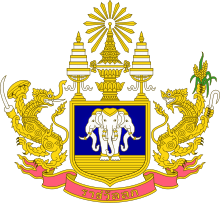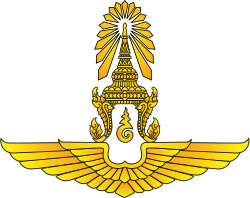1st Infantry Regiment (Thailand)
| 1st Infantry Regiment, King's Own Bodyguard | |
|---|---|
| กรมทหารราบที่ 1 มหาดเล็กรักษาพระองค์ | |
 Rajawallop insignia, the official emblem of the 1st Infantry Regiment, King's Own Bodyguard | |
| Active | 1859-present |
| Country |
|
| Branch |
|
| Type | Infantry |
| Size | Regiment |
| Garrison/HQ | Phayathai District, Bangkok |
| Nickname(s) |
Thahan Mahat Lek Rajawallop (มหาดเล็กราชวัลลภ, King's close bodyguards) Thahan Song Lo (ทหารสองโหล, Two-Dozen soldiers) Mahat Lek Lai Ka (มหาดเล็กไล่กา, Scarecrow Corps) |
| Colors | Red-White |
| March |
Royal Guards March (มาร์ชราชวัลลภ, March Raja Vanlok) |
| Engagements |
Franco-Thai War Pacific War Korean War Vietnam War |
| Website | www.1stinfantryreg.in.th |
| Insignia | |
| Unit colours |
 |
The 1st Infantry Regiment, King's Own Bodyguard (Thai: กรมทหารราบที่ 1 มหาดเล็กรักษาพระองค์) (ร.1 รอ.) is a King's Guard regiment under the 1st Infantry Division, King's Guard of the Royal Thai Army. The regiment is divided into three battalions, all of them based in Bangkok. The regiment is the only unit of the Royal Thai Armed Forces with the designation Mahat Lek Rajawallop (Thai: มหาดเล็กราชวัลลภ); meaning the king's close bodyguards, translated as the King's Own Bodyguards. The unit was first established by King Chulalongkorn (Rama V) in 1859, whilst he was still a young prince. One of the primary role of the regiment is to provide security and protection to members of the Thai Royal Family as well as the ceremonial escort and guarding of the royal palaces. The unit is the oldest regiment of the Thai army.
History
The Royal Guards were established by King Chulalongkorn (Rama V) of Siam in 1859, when he was still a young prince. Initially, the Royal Guards were servants with duties such as scaring crows, which led to commoners referring to them as the "Mahat Lek Lai Ka," roughly translated as "Scarecrow Corps."
When he succeeded his father in 1868, King Chulalongkorn took his Royal Guard and formed a 24-strong Royal Bodyguard, referred to as the "Thahan Song Lo" (Two-Dozen soldiers"). In 1870, the unit was upgraded into a full army regiment and was given the name the "King's Guard" and their duties included escorting the king while he travelled around the country.
The king commanded the regiment himself until 1873, when he appointed Lieutenant General Chao Phraya Phasakornwongse as its first military commander.
The Royal Guards still exist down to the present and serve as protectors of the Royal Family of Thailand.[1][2]
Organization
Active
- 1st Infantry Battalion, 1st Infantry Regiment, King's Own Bodyguard (King Chulalongkorn's Own Guards)
- 2nd Infantry Battalion, 1st Infantry Regiment, King's Own Bodyguard (King Chulalongkorn's Own Guards)
- 3rd Infantry Battalion, 1st Infantry Regiment, King's Own Bodyguard (King Vajiravudh's Own Guards)
Dissolved
- 4th Infantry Battalion, 1st Infantry Regiment, King's Own Bodyguard (King Chulalongkorn's Own Guards) (amalgamated with the Royal Security Command in 2017)
Uniforms
The 1st and 2nd battalions wears a ceremonial uniform of scarlet red and black facings and a bearskin-styled cap based on the British Army Foot Guards with a row of single buttons (similar to those used by the British Grenadier Guards). The 3rd Battalion however wears a ceremonial uniform of white and shocking pink facings and pink plumed bearskin helmet, by the orders of King Vajiravudh (Rama VI) who founded the battalion as a separate unit in 1912, but with the same single buttons. The ceremonial uniform is worn only when the regiment is on duty in a public royal ceremony with a member of the royal family present. When providing guard on royal premises, such as the Grand Palace, the soldiers wear a white uniform with a pith helmet.
Notable members
- Prince Bhanurangsi Savangwongse Commander of the regiment 1879-1885
- Prince Damrong Rajanubhab Commander of the regiment 1885-1892
- Crown Prince Maha Vajiravudh (later King Rama VI) Commander of the regiment 1901-1910
- Prince Chakrabongse Bhuvanath Commander of the regiment 1910-1919
- Paribatra Sukhumbandhu Commander of the regiment 1923-1932
- Field Marshal Sarit Thanarat Commander of the regiment 1945-1948, Prime Minister of Thailand 1958-1963
- Field Marshal Praphas Charusathien Commander of the regiment 1948-1951, Commander in Chief of the Army 1964-1973
- Prince Mahidol Adulyadej as a special Colonel of the regiment
- HM King Maha Vajiralongkorn as a battalion commander in 1980
- Princess Maha Chakri Sirindhorn, the Princess Royal as an honorary Captain of the regiment
Gallery
 King Chulaongkorn, the founder of the unit, in the scarlet uniform of the regiment
King Chulaongkorn, the founder of the unit, in the scarlet uniform of the regiment King Prajadhipok in the scarlet uniform, with the old style helmet to the right of the picture
King Prajadhipok in the scarlet uniform, with the old style helmet to the right of the picture- Regimental colours of the 1st Infantry Regiment, King's Own Bodyguard
- Red ceremonial uniform of the regiment, used by the 1st, 2nd battalion and former 4th battalion
 Distinctive white and pink uniform of the 3rd Battalion
Distinctive white and pink uniform of the 3rd Battalion- White uniforms of the regiment, changing of the guards at the Grand Palace in Bangkok
See also
| Wikimedia Commons has media related to 1st Infantry Regiment, King's Own Bodyguard (Thailand). |

